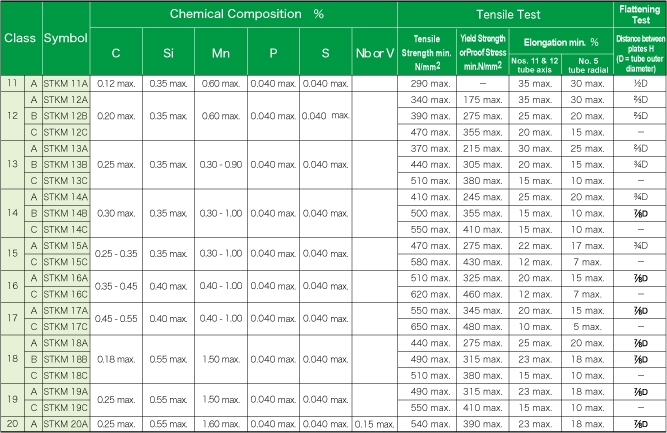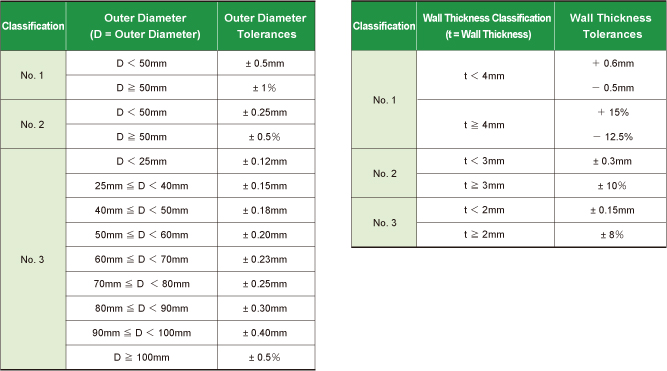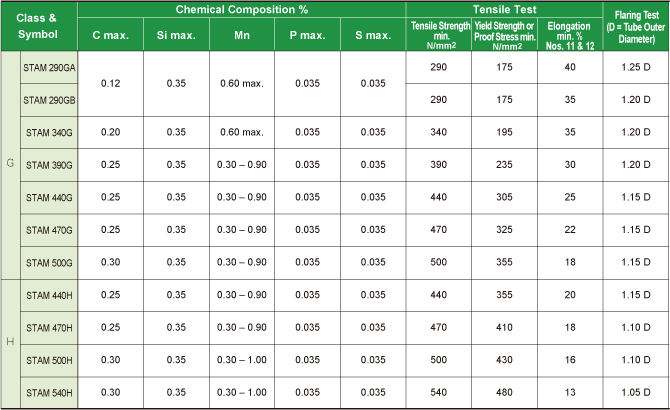
All of our carbon steel tubes for machine structures are manufactured in accordance with the Japanese Industrial Standards (JIS).
We also manufacture qualities of material besides JIS standards as well as high-carbon steel tubes, high strength steel tubes with a tensile strength on the order of 780N/mm2 and 980N/mm2, and quench-hardened high strength steel tubes. Please contact us to discuss your needs.
JIS G 3445(2016) Carbon Steel Tubes for Machine Structures

Notes:
- Alloying elements not stipulated in this table may be added as necessary.
- The lower limit of C can be changed for class 15 tubes on agreement between the receiving and delivering parties.
- Nb and V can be added in combination for class 20 tubes. In this case, the amount of Nb + V will be a maximum of 0.15%.
- The No. 12 and No. 5 test pieces are taken form portions that do not include seams.
- When performing the tensile test with the No. 12 and No. 5 test pieces on tubes with a wall thickness of less than 8 mm, the minimum elongation value shall be the value obtained by subtracting 1.5% from the given elongation value for each 1 mm reduction from the thickness of 8 mm and rounding off to an integer in accordance with rule A of JIS Z8401.
- The elongations given do not apply to tubes with an outer diameter of 40 mm or less.
However, the test results are recorded. Also, the elongations may be stipulated on agreement between the receiving and delivering parties.
- The elongations shown in this table do not apply to tubes that have not undergone heat treatment after cold finishing. However, the test results are recorded. Also, the elongations may be stipulated on agreement between the parties.
- The minimum value for the distance between plates (H) in the flattening test shall be at least five times the wall thickness.

Notes:
- Which classification to apply depends on the agreement between the receiving and delivering parties.
- The wall thickness tolerances shall be +50/0mm. However, when tolerances other than these are needed, those tolerances shall depend on the agreement between the receiving and delivering parties.
JIS G 3472 (2007) Electric Resistance Welded Carbon Steel Tubes for Automobiles

Notes:
- On agreement between the receiving and delivering parties, Nb or V may be added individually or in combination up to a maximum of 0.15% as necessary. Also, except for Nb and V, alloying elements besides those given here may be added as necessary.
- On agreement between the receiving and delivering parties, the lower limit of C can be negotiated as necessary.
- With respect to STAM470G, STAM470H, STAM500G, STAM590G, and STAM540H, the upper limit of Mn can be increased by 0.06% for each 0.01% reduction in the upper limit given for C. However, the upper limit for Mn in this case shall be 1.50%
- In the case of cold finished tubes that have not undergone further treatment, the given elongation shall be a minimum 10% and the flaring test shall not apply.
- When performing the tensile test with the No. 12 test piece on tubes with a wall thickness of less than 8 mm, the minimum elongation value shall be the value obtained by subtracting 1.5% from the given elongation value for each 1 mm reduction from the thickness of 8 mm and rounding off to an integer in accordance with rule A of JIS Z8401.
- The elongations given do not apply to tubes with an outer diameter of less than 40 mm. However, the elongation values may be stipulated on agreement between the receiving and delivering parties.

Notes:
- Outer diameter tolerances do not apply to the ends of tubes. The tolerances for classification No. 1 apply to tubes as welded, those for classification No. 2 apply to tubes as welded or cold finished steel tubes, and those for classification No. 3 apply to cold finished steel tubes.
- Wall thickness tolerances do not apply to welds. The usual tolerances for classification No. 3 apply, as a general rule, to cold finished steel tubes.
- Tolerances for uneven tube thickness (excluding welds) shall be a maximum of 50% of the range of the wall thickness tolerances.
 Notes:
Notes:
 Notes:
Notes:
 Notes:
Notes:
 Notes:
Notes: